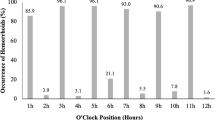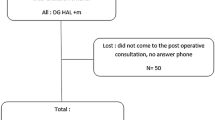Abstract
Introduction
Doppler-guided transanal hemorrhoidal dearterialization (THD) was considered a less invasive and innovative method to treat hemorrhoidal disease, but it may impact the anal area during dearterialization and mucopexy. Thus, this study aimed to assess any changes in anorectal manometry of grade III and IV hemorrhoidal patients following THD treatment.
Methods
This prospective observational study was conducted with patients who had grades III and IV hemorrhoidal disease. The patients were treated using THD at the Department of Surgery in the National Hospital of Traditional Medicine (Hanoi, Vietnam) between June 2012 and December 2013. Anorectal manometry was performed prior to THD and again between 6 and 12 months following the procedure.
Results
A total of 40 patients were enrolled in the study, including 32 with grade III hemorrhoids and 8 with grade IV hemorrhoids. The proportion of male patients (65%) was higher than that of female patients (35%), and the majority of patients (82.5%) were > 40 years old. The mean duration of symptoms prior to treatment was 12.3 years. The mean length of the anal sphincter was unchanged before and after THD (3.64 ± 0.40 cm prior to treatment vs. 3.66 ± 0.48 cm following treatment; p = 0.57). Significant differences in treatment-related changes were detected for all anorectal manometric measurements except maximum squeezing pressure (p < 0.05). No patient showed anal stenosis or fecal incontinence.
Conclusion
The THD technique did not change the length of the anal sphincter 6 months after hemorrhoid treatment. The values of anal pressure and rectal sensation decreased almost significantly between treatment and the follow-up visit. We suggest that further studies, which include larger sample sizes, should be conducted to confirm THD effectiveness in terms of anorectal functions.

Similar content being viewed by others
References
Ratto C. THD Doppler procedure for hemorrhoids: the surgical technique. Tech Coloproctol. 2014;18(3):291–8.
Ratto C, de Parades V. Doppler-guided ligation of hemorrhoidal arteries with mucopexy: a technique for the future. J Visc Surg. 2015;152(2 Suppl):S15–21.
Figueiredo MN, Campos FG. Doppler-guided hemorrhoidal dearterialization/transanal hemorrhoidal dearterialization: technical evolution and outcomes after 20 years. World J Gastrointest Surg. 2016;8(3):232–7.
Giordano P, Tomasi I, Pascariello A, Mills E, Elahi S. Transanal dearterialization with targeted mucopexy is effective for advanced haemorrhoids. Colorectal Dis. 2014;16(5):373–6.
LaBella GD, Main WP, Hussain LR. Evaluation of transanal hemorrhoidal dearterialization: a single surgeon experience. Tech Coloproctol. 2015;19(3):153–7.
Giamundo P. Advantages and limits of hemorrhoidal dearterialization in the treatment of symptomatic hemorrhoids. World J Gastrointest Surg. 2016;8(1):1–4.
Trenti L, Biondo S, Galvez A, Bravo A, Cabrera J, Kreisler E. Distal Doppler-guided transanal hemorrhoidal dearterialization with mucopexy versus conventional hemorrhoidectomy for grade III and IV hemorrhoids: postoperative morbidity and long-term outcomes. Tech Coloproctol. 2017;21(5):337–44.
Cuong LM, Ha TT, Anh NN, Thanh NT, Kien VD, Lam ND. Comparison of Doppler-guided transanal hemorrhoidal dearterialization for grade III and IV hemorrhoids in Vietnam. Adv Ther. 2019;36(6):1388–97.
Ratto C, Campenni P, Papeo F, Donisi L, Litta F, Parello A. Transanal hemorrhoidal dearterialization (THD) for hemorrhoidal disease: a single-center study on 1000 consecutive cases and a review of the literature. Tech Coloproctol. 2017;21(12):953–62.
Haskins IN, Holzmacher J, Obias V, Agarwal S. The use of transanal hemorrhoidal dearterialization for treatment of hemorrhoid disease at a single institution. Am Surg. 2016;82(12):1160–2.
Ratto C, Parello A, Donisi L, Litta F, Doglietto GB. Anorectal physiology is not changed following transanal haemorrhoidal dearterialization for haemorrhoidal disease: clinical, manometric and endosonographic features. Colorectal Dis. 2011;13(8):e243–5.
Walega P, Romaniszyn M, Kenig J, Herman R, Nowak W. Doppler-guided hemorrhoid artery ligation with recto-anal-repair modification: functional evaluation and safety assessment of a new minimally invasive method of treatment of advanced hemorrhoidal disease. Sci World J. 2012;2012:324040.
Wanga SK, Lemeshow S. Sample size determination in health studies. A practical manual Ginebra. Geneva, Switzerland: World Health Organization; 1991.
Goligher JC. Surgery of the anus, rectum and colon. 4th ed. London, UK: Bailliere Tindall; 1980. p. 924–5.
Ratto C, Donisi L, Parello A, Litta F, Zaccone G, De Simone V. ‘Distal Doppler-guided dearterialization’ is highly effective in treating haemorrhoids by transanal haemorrhoidal dearterialization. Colorectal Dis. 2012;14(11):e786–9.
Xu L, Chen H, Lin G, Ge Q, Qi H, He X. Transanal hemorrhoidal dearterialization with mucopexy versus open hemorrhoidectomy in the treatment of hemorrhoids: a meta-analysis of randomized control trials. Tech Coloproctol. 2016;20(12):825–33.
Hoyuela C, Carvajal F, Juvany M, Troyano D, Trias M, Martrat A, et al. HAL-RAR (Doppler guided haemorrhoid artery ligation with recto-anal repair) is a safe and effective procedure for haemorrhoids. Results of a prospective study after 2-year follow-up. Int J Surg. 2016;28:39–44.
Tsunoda A, Takahashi T, Kusanagi H. A prospective randomized trial of transanal hemorrhoidal dearterialization with mucopexy versus ultrasonic scalpel hemorrhoidectomy for grade III hemorrhoids. Tech Coloproctol. 2017;21(8):657–65.
Bharucha AE, Rao SS. An update on anorectal disorders for gastroenterologists. Gastroenterology. 2014;146(1):37–45.
Wald A, Bharucha AE, Cosman BC, Whitehead WE. ACG clinical guideline: management of benign anorectal disorders. Am J Gastroenterol. 2014;109(8):1141–57.
Bharucha AE. Difficult defecation: difficult problem assessment and management; what really helps? Gastroenterol Clin N Am. 2011;40(4):837–44.
Bharucha AE, Fletcher JG, Harper CM, Hough D, Daube JR, Stevens C, et al. Relationship between symptoms and disordered continence mechanisms in women with idiopathic faecal incontinence. Gut. 2005;54(4):546–55.
Rao SS. Pathophysiology of adult fecal incontinence. Gastroenterology. 2004;126:S14–22.
Hong YK, Choi YJ, Kang JG. Correlation of histopathology with anorectal manometry following stapled hemorrhoidopexy. Ann Coloproctol. 2013;29(5):198–204.
Noelting J, Ratuapli SK, Bharucha AE, Harvey DM, Ravi K, Zinsmeister AR. Normal values for high-resolution anorectal manometry in healthy women: effects of age and significance of rectoanal gradient. Am J Gastroenterol. 2012;107(10):1530.
Li Y, Yang X, Xu C, Zhang Y, Zhang X. Normal values and pressure morphology for three-dimensional high-resolution anorectal manometry of asymptomatic adults: a study in 110 subjects. Int J Colorectal Dis. 2013;28(8):1161–8.
Lee H, Jung K, Han S, Kim J, Park SK, Yoon I, et al. Normal values for high-resolution anorectal manometry/topography in a healthy Korean population and the effects of gender and body mass index. Neurogastroenterol Motil. 2014;26(4):529–37.
Coss-Adame E, Rao SS, Valestin J, Ali-Azamar A, Remes-Troche JM. Accuracy and reproducibility of high-definition anorectal manometry and pressure topography analyses in healthy subjects. Clin Gastroenterol Hepatol. 2015;13(6):1143–50.
Lee TH, Bharucha AE. How to perform and interpret a high-resolution anorectal manometry test. J Neurogastroenterol Motil. 2016;22(1):46–59.
Azpiroz F, Enck P, Whitehead WE. Anorectal functional testing: review of collective experience. Am J Gastroenterol. 2002;97(2):232–40.
Prichard D, Harvey DM, Fletcher JG, Zinsmeister AR, Bharucha AE. Relationship among anal sphincter injury, patulous anal canal, and anal pressures in patients with anorectal disorders. Clin Gastroenterol Hepatol. 2015;13(10):1793–800.
Leroi A-M, Berkelmans I, Denis P, Hémond M, Devroede G. Anismus as a marker of sexual abuse. Dig Dis Sci. 1995;40(7):1411–6.
Acknowledgements
The authors thank the patients and healthcare professionals who participated in this study.
Funding
No funding or sponsorship was received for this study or publication of this article. The journal’s rapid service fee was funded by the authors.
Authorship
All named authors meet the International Committee of Medical Journal Editors (ICMJE) criteria for authorship for this article, take responsibility for the integrity of the work as a whole, and have given their approval for this version to be published.
Disclosures
The authors Le Manh Cuong, Vu Nam, Tran Thai Ha, Tran Thu Ha, Tran Quang Hung, Do Van Loi, Tran Manh Hung, Nguyen Van Son and Vu Duy Kien have nothing to disclose.
Compliance with Ethics Guidelines
All procedures performed in studies involving human participants were in accordance with the ethical standards of the Military Medical University committee, Vietnam, and with the 1964 Helsinki Declaration and its later amendments or comparable ethical standards. Approval to conduct the study was obtained from the committee of the Military Medical University, Vietnam, by the Decision no. 2858/QD-HVQY. Informed consent was obtained from all individual participants included in the study.
Data Availability
The datasets generated during and/or analyzed during the current study are available in the Figshare repository, https://doi.org/10.6084/m9.figshare.11342642.
Author information
Authors and Affiliations
Corresponding author
Additional information
Enhanced Digital Features
To view enhanced digital features for this article go to https://doi.org/10.6084/m9.figshare.11605455.
Rights and permissions
About this article
Cite this article
Cuong, L.M., Nam, V., Ha, T.T. et al. Anorectal Functional Outcomes Following Doppler-Guided Transanal Hemorrhoidal Dearterialization: Evidence from Vietnam. Adv Ther 37, 1136–1144 (2020). https://doi.org/10.1007/s12325-020-01238-9
Received:
Published:
Issue Date:
DOI: https://doi.org/10.1007/s12325-020-01238-9




